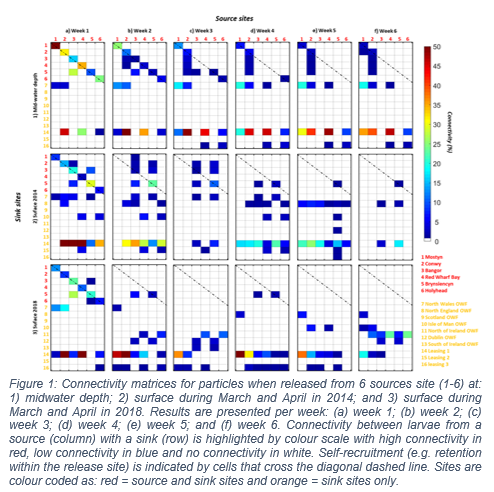A NUMERICAL STUDY OF SHELLFISHERIES AQUACULTURE AND OFFSHORE RENEWABLE ENERGY CO-LOCATION IN THE IRISH SEA
Introduction
The worldwide increase of demand for aquaculture and energy requires developing efficient tools to study the possibility of multi-use platforms at sea (MUPS) and reduce the anthropic pressure on space availability. Offshore renewable energy (ORE) in the Irish Sea will occupy approximately 14% (6,564 km2) of the space in a close future. Blue mussels industry (Mytilus edulis L.) in North wales represents one third of the UK production and could be impacted by the development of other industries (Hambrey & Evans, 2016). Several studies defined a sustainable index (SI) for the co-location of aquaculture and offshore wind farms, which includes physical (i.e. wind velocity, depth range, tidal current) and biological (i.e. sea surface temperature, chlorophyll-a concentration) factors (Di Tullio et al., 2018). However, no studies took into account larvae dispersal as a factor for SI to determine the best location to catch shellfish. In order to determine the best suitable area for co-location, we used a lagrangian particle tracking model (PTM) coupled to hydrodynamic model to qualify and quantify: (1) the density distribution of mussel larvae; and (2) the connectivity between aquaculture (6 sites) and ORE (10 sites).
Material and methods
Telemac-2D depth average model with mesh density varying from 30 m to 5,000 m. The domain covered an area of 165,000 km2, which correspond to the whole Irish Sea as previous studies show that larvae can potentially travel up to 300 km (Van der Molen et al., 2007). A Lagrangian PTM was developed to predict mussel larvae dispersal from 6 sites for a pelagic larvae duration (PLD) of 45 days. Simulations were performed for two larvae behaviour (i.e. dispersal at the surface and at mid-water depth) during spring of two contrasted year (i.e. 2014 and 2018 showed different wind patterns).
Results
Density distribution showed the same results during spring 2014 and 2018 when larvae travel at mid-water depth. However, the density distribution varied during the PLD and according to the site of release.
Density distribution varied inter-annually when larvae travelled at the surface. Results also showed a difference between release sites and during the PLD.
Connectivity results showed that the site leasing 1 is the most connected with released sites for all simulated years and behaviour (Figure 1). However, the connectivity with leasing 1 site varied through the PLD (Figure 1). Furthermore, results showed that during spring 2014, aquaculture sites are connected with offshore wind farms located in the eastern Irish Sea (i.e. North Wales and North of England) whereas during 2018 they are connected with ORE located in the western Irish Sea (i.e. Dublin and North of Ireland) (Figure 1).
Discussion
The simulated larvae behaviours results showed that when larvae travel at the surface they encountered stronger currents (e.g. wind driven currents), which increased their dispersal. Results observed when mussel larvae travel at the surface are correlate with observations made by mussel farmers during the year 2014 and 2018. The results highlight the importance of vertical position of larvae in the water column to study potential multi-use platforms at sea. However, the leasing site 1 is potentially the best area to develop MUPS in the Irish Sea. This study shows the importance of considering larvae dispersal for the development of sustainable index to define best area for MUPS.
References
G.R. Di Tullio, P. Mariani, G. Benassai, D. Di Luccio & L. Grieco (2018). “Sustainable use of marine resources through offshore wind and mussel farm co-location”. Ecological Modelling, 367: 34-41.
J. Hambrey & S. Evans (2016). “SR694 Aquaculture in England, Wales and Northern Ireland: an analysis of the economic contribution and value of the major sub-sectors and the most important farmed species,” Seafish.
J. Van der Molen, S.I. Rogers, J.R. Ellis, C.J. Fox & P. McCloghrie (2007). “Dispersal patterns of the eggs and larvae of spring-spawning fish in the Irish Sea, UK,” Journal of Sea Research, 58(4): 313-330
